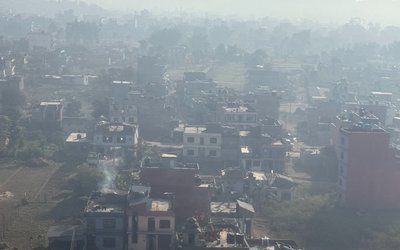Indian PM Narendra Modi recently announced that Sarada River will be linked with Yamuna to revive it, for spatial transfer of water – transferring water from Mahakali to Yamuna. It is a small part of India’s ambitious river linking scheme.
Water from Nepalin Yamuna
Actually, Mahakali River,deemed to be a border river between Nepal and India, is called Sarada in India, which flows southeast and empties into Ghaghara River (called Karnali in Nepal) near Baharaich in UP. A dam will be built at Jamarani on Mahakali River, few kilometresnorth of Tanakpur barrage, and water diverted by a canalheading straight west to joinYamuna.
Plight of Yamuna
Kathmanduites find Bagamati foul but fish is still found. Whereas Yamuna is in worse condition, especially due to heavy extraction of water for irrigation, domestic water supply and industrial uses in neighbourhoods like Hathnikund/Tajewala, Wazirabad, Okhla, resulting in low flow and dumping of industrial effluence without treatment
Adverse impact on Mahakali/Sarada River
After diversion of water from Mahakali, the quantum of water flowing downstream will get reduced substantially and dry season flow in Ghaghara, consequently in Ganga, will also decrease which will cause water stress in UP, India. It will also adversely impact 120 MW Tanakpur hydropower plant (presently run of river), lowering dry seasongeneration, thereby reducingvaluable firm energy.
Further, Mahakali flood also will be transferred to Yamuna. Therefore, Yamuna will be fraught with doubled flood, its own and that of Mahakali.
Hence, spatial transfer of water from Mahakali to Yamuna will make no sense: no incremental flow in dry season when needed and doubled flood in monsoon, creating havoc in southern Uttarakhand, north western UP and even Delhi.
Role of Pancheshwar Project
However, after implementation of 6,480 MW Pancheshwar multipurpose hydropower project, linking Mahakali with Yamuna will add value significantly; as reservoir will transfer water from wet season to dry season, thereby contributing more water to Ghaghara and, eventually to Ganga in dry season (with commensurate reduction in flood), notwithstanding diversion from Mahakali to Yamuna. Additionally, with Pancheshwar powerhousegenerating peaking power, Tanakpur, becoming a cascade project with Pancheshwar, too will start generating not only more electricity in dry season compared to now but will start to generatepeaking power (high value power) andits firm power will increase substantially.
Lean season augmented flow
Positive externalities of Pancheshwar are flood control and lean season augmented flowof 582 m3/s,benefitting both Nepal and India. However, both countries will also suffer from inundation and involuntary displacement – negative externalities.
Mahakali Treaty has stipulated that two countries are entitled to equal share of water; Nepal and Indiaeach entitled to 291 m3/s of lean season augmented flow. However, as the treaty also stipulates that Nepal will “have right to supply of 4.25 m3/s in dry season”, India will be using 286.75 m3/s of Nepal’s share and the idea of linking Yamuna with Mahakali is rooted in capturingNepal’s share of lean season augmented flow.
However, it is against the spirit of equality enshrined in Mahakali treaty for India to take Nepal’s share free of cost. What needs to be remembered is that the lean season augmented flow will be generated by Nepaltoo bearing negatives externalities. It is logical for India to enjoy its share of lean season augmented flow of 291 m3/s, havingborne commensuratenegative externalities.
For India to use 286.75 m3/s of Nepal’s share, former will have to recompense latter based on internationally accepted principle. An example is agreement between Lesotho and South Africa, under which latter pays former at the rate of $25 million/year for 18 m3/s; at which rate India will have to pay Nepal $ 398 million (equivalent to Rs 40 billion) a year.
It is not mandatory that Nepal and India, two close neighbours, apply the rate used by two African countries. Different rate or different recompense mechanism can be worked out. However, it will not be possible for India to use Nepal’s share of Mahakali water pro bono(or by giving some free electricity like from Tanakpur) or in the lines of Koshi and Gandaki barrages, built in 50s, under which Nepal ended up internalizing negative externalities with India solely enjoying positive externalities without recompense for the former and sharing the latter.
It shouldn’t be forgotten that the proposal here is NOT for India to pay for water flowing naturally; payment is for storage of water, requiringNepal to suffer from inundation and involuntary displacement.
Existing Consumptive Use
Nepal’s hydrocrats have opined that, as equal share of water is subject to proviso of “without prejudice to prior existing consumptive use”, India cannot be expected to recompenseNepal for the use of water “belonging to Nepal” since India’s “prior existing consumptive use” is 326 m3/s. In their opinion Nepal is entitled to only half of 256 m3/s (128 m3/s) after deducting 326 m3/s from 582 m3/s. It is natural for Indian patriots to opine as such, but it isn’t befitting those claiming to be “patriots” of Nepal.
The proviso clause is applicable for the currently obtaining situation when Mahakali is fraught with drought for more than 6 months and flood in monsoon, but not applicable for lean season augmented flow generated by suffering inundation and displacement. Huge opportunity cost is suffered due to inundation of cultivable land, forest, etc. and displacement of populace who have to be resettled.Land in Nepal gets used twice: in inundation and resettlement.
Nepal Needs no Additional water
Hydrocrats in Nepal and many Indians opine that Nepaldoesn’t need 286.75 m3/s, whichIndia plans to use, in addition to India’s half share, and a neighbouring country shouldn’t make fuss about such things. It is but natural for Indians to say this. But Nepal’s hydrocrats parroting it is unbecoming. If India is to use Nepal’s share of water free of cost, then why should Nepalsuffer from inundation and displacement. Best will be to tailor the dam height to generate just 8.5 m3/s lean season augmented flow and Nepal and India can share 4.25 m3/s each.
Alternative Approach
Sarada barrage was built by BritishIndia under 1920 treaty after compensating Nepal with 4,000 acres land inundated by the barrage. It can be replicated in Pancheshwar:Indiato compensateNepal’s inundated land with land in India(then no recompense will be expected).
Potential and Challenge
There is potential of benefit for southern area of Uttarakhand, western UP and Delhi from temporal transfer of water after completion of Pancheshwar. However, spatial transfer will amount to extension of drought and flood.
There is a challenge too.In order for Nepal to agree to “give” her share of lean season augmented flow to India after construction of Pancheshwar reservoir, India will have to agree to share opportunity cost of negative externalitiesthat Nepal bears and share benefit of positive externalities with Nepal that India will enjoy.
- Economic And Financial Assessment Of MCC
- Dec 05, 2021
- Prudent Harnessing of Water Resources
- Jan 29, 2015
- Implementing Pancheshwar in Nepal’s Interest
- Jul 26, 2014
- Colonization of Water Resources
- May 10, 2014















